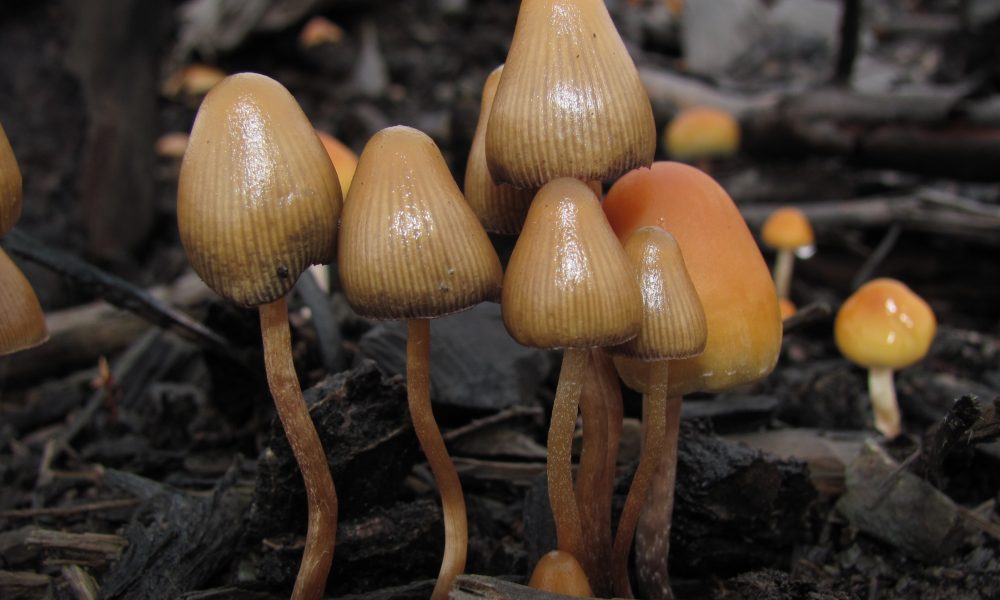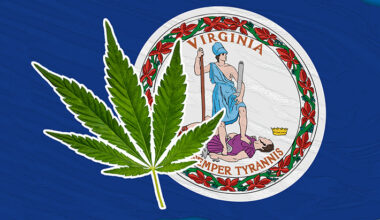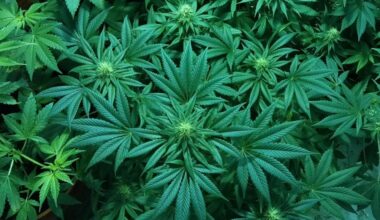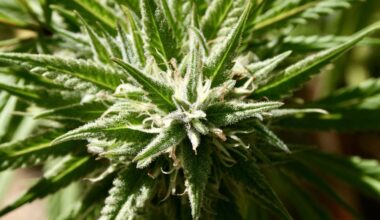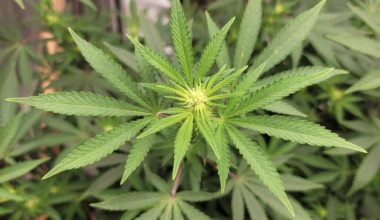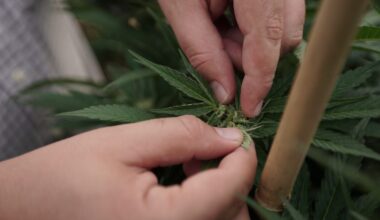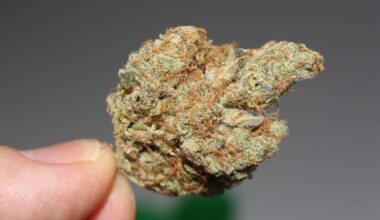The U.S. House of Representatives on Thursday approved a package of spending legislation that contains measures to provide protections for banks that work with state-legal cannabis businesses and allow the legalization of marijuana sales in Washington, D.C., among many other drug policy provisions.
The appropriations legislation and attached reports also direct federal government agencies to reconsider policies that fire employees for using cannabis in compliance with state law, criticize restrictive hemp regulations, encourage CBD to be allowed in foods and urge expanded research on marijuana and other substances.
While not every included provision is pro-reform—and some measures that activists wanted to see added were blocked— advocates are generally pleased with the wide range of issues addressed in the “minibus” legislation that covers annual funding for the Departments of Labor, Health and Human Services, Education, Agriculture, Rural Development, Energy and Water Development, Financial Services and General Government, Interior, Environment, Military Construction, Veterans Affairs, Transportation, and Housing and Urban Development.
And they are looking forward to votes on even more far-reaching marijuana amendments that are up for consideration on separate spending bills—such as those covering the Department of Justice—that are expected to be considered soon.
Here’s a breakdown of the cannabis and drug policy provisions that are attached to the bill approved on Thursday:
The legislation restricts the use of certain funds to punish banks for working with marijuana businesses:
“None of the funds made available in this Act may be used to penalize a financial institution solely because the institution provides financial services to an entity that is a manufacturer, a producer, or a person that participates in any business or organized activity that involves handling hemp, hemp-derived cannabidiol products, other hemp-derived cannabinoid products, marijuana, marijuana products, or marijuana proceeds, and engages in such activity pursuant to a law established by a State, political subdivision of a State, or Indian Tribe. In this section, the term ‘State’ means each of the several States, the District of Columbia, and any territory or possession of the United States.”
The provision, which only covers restrictions on the Treasury Department, is less far-reaching than more robust bills the House has passed on four occasions, but it would still provide some protections to financial institutions that work with state-legal marijuana operators.
When it comes to D.C. marijuana policy, local voters legalized personal possession and cultivation in 2014. But a congressional rider has prevented the local government from using its tax dollars to regulate retail sales. That would change if the House-passed bill—which does not contain the provision—is enacted, despite the fact that a budget proposal from President Joe Biden seeks to maintain the provision on denying D.C. autonomy to legalize marijuana commerce.
After the Biden budget was released, Rep. Eleanor Holmes Norton (D-DC) told Marijuana Moment that she was “very disappointed” over the decision, especially considering that fact that he’s voiced support for statehood for the District.
The current blockade on D.C. cannabis sales is the result of an amendment that was first added by Rep. Andy Harris (R-MD) when Republicans controlled the House and has since been continued in annual appropriations legislation. The House on several occasions has since passed spending bills that do not include the cannabis ban, but it has been included in final enacted legislation because the Senate under GOP control insisted on reinserting it. That could change this year when the chamber takes up its version of spending legislation.
—
Marijuana Moment is already tracking more than 1,100 cannabis, psychedelics and drug policy bills in state legislatures and Congress this year. Patreon supporters pledging at least $25/month get access to our interactive maps, charts and hearing calendar so they don’t miss any developments.![]()
Learn more about our marijuana bill tracker and become a supporter on Patreon to get access.
—
The part of the bill funding the Department of Education has a new provision that says universities can’t be punished for studying marijuana:
“None of the funds appropriated by this title for the Department of Education shall be withheld from an institution of higher education solely because that institution is conducting or preparing to conduct research on marihuana as defined in 21 U.S.C. 802(16).”
The report attached to the bill reenforces the point:
“Protecting Scientific Research on Marihuana.—Through scientific research, institutions of higher education advance our understanding and knowledge of various aspects of our world. Moreover, when in the public interest, such institutions should be able to conduct such research without fear of reprisal or loss of Federal funding. This includes research on cannabis, a Schedule I controlled substance under the Controlled Substances Act. As more States and localities move to legalize cannabis, many institutions of higher education are expanding the knowledge-base on this controlled substance. As a result, the Committee notes that such research is in the public interest, and the recommendation includes new bill language prohibiting the Department from penalizing institutions of higher education that conduct scientific research on marihuana.”
Rep. Debbie Lesko (R-AZ) attempted delete the bill language on university protections with a floor amendment, arguing that that not passing her amendment would “permit universities to offer a class called ‘Pot Smoking 101’ [that’s] dedicated to smoking pot under the false pretense of research.” But colleagues overwhelmingly defeated her attempt in a bipartisan vote.
Additional report language attached to the wide-ranging spending legislation by the House Appropriations Committee includes a number of passages about marijuana and drug policy.
One provision encourages a review of employment policies for federal agencies with respect to personal use of cannabis.
“Federal Employment Guidelines.—The Committee supports the updated guidance on agencies’ consideration of how an individual’s marijuana use may or may not adversely affect the integrity or efficiency of the government and impact an individual’s suitability or fitness for a position. The Committee encourages OPM and the Suitability Executive Agent to continue to review these policies and guidelines regarding hiring and firing of individuals who use marijuana in states where that individual’s private use of marijuana is not prohibited under the law of the State. These policies should reflect updated changes to the law on marijuana usage and clearly state the impact of marijuana usage on Federal employment.”
Report provisions also touch on the need to expand cannabis and psychedelics research. The panel urged the National Institute On Drug Abuse (NIDA) to support expanded marijuana studies, for example:
“Cannabis Research.—The Committee encourages NIDA to support coordinated, multidisciplinary cannabis research, including basic, clinical, and translational cannabis research and research on the health effects of cannabis use, potential therapeutic effects of cannabis use, and effects of cannabis legalization. NIDA is encouraged to support peer-reviewed scientific research, graduate and postdoctoral fellowships, and any required infrastructure, with priority given to research programs in States where State co-funding is available.”
Report language also says that federal health agencies should pursue research into the therapeutic potential of psychedelics for military veterans suffering from a host of mental health conditions.
“Psychedelic Treatments.—Despite the recent Department of Veterans Affairs’ 2020 National Veteran Suicide Prevention Annual Report that showed there were no significant increases in the veteran suicide rate from 2017 and 2018, the Committee is concerned that over 17 veterans on average continue to commit suicide each day, which is a number that has remained persistent over the past decade. There have been many recent studies and clinical trials demonstrating the positive impact of alternative therapies, including psychedelics, for treatment resistant post-traumatic stress disorder (PTSD) and major depressive disorder, particularly for veteran participants. In light of growing interest in this area, the Committee encourages NIH and other relevant Federal agencies to undertake, and where appropriate expand, research to evaluate the effectiveness of psychedelic therapies in treating PTSD, major depressive disorder, and other serious mental health conditions.”
It goes on to mandate that the National Institutes of Health (NIH) work with the Food and Drug Administration (FDA), Drug Enforcement Administration (DEA), White House Office of National Drug Control Policy (ONDCP) and other relevant agencies to broaden access for researchers to obtain marijuana and other Schedule I drugs, which can be difficult to access due to their restricted status under federal law:
“Schedule I Drug Research.—The Committee recognizes that, despite marijuana being legalized in some form in 35 States and nearly 45,000,000 American adults reporting having used marijuana in the past year, research on marijuana and other Schedule I substances is extremely limited. The Committee directs NIH, in collaboration with FDA, DEA, ONDCP, and any other relevant agencies, to develop an approach to facilitate access to Schedule I drugs for research.”
Another passage concerns individual marijuana components, including CBD, minor cannabinoids and terpenes, noting that the panel “strongly believes” they “may provide beneficial medicinal effects” but that more studies are needed:
“Cannabidiol Research.—The Committee strongly believes that cannabidiol (CBD), cannabigerol (CBG), cannabichromene (CBC), minor cannabinoids, and terpenes—compounds found in cannabis— may provide beneficial medicinal effects. However, there is insufficient scientific information about the short- and long-term effects of these compounds. The Committee is also concerned that marijuana policies on the Federal level and in the States are being changed without the benefit of scientific research to help guide those decisions. Additional, coordinated research on a national scale is necessary to determine the toxicology and medicinal effects of these compounds. The Committee believes that NIH should consider significantly expanding funds to study the medicinal effects and toxicology of CBD, CBG, CBC, minor cannabinoids, and terpenes. This expanded effort should include funding of clinical trials with academic health centers to study the long-term medicinal benefits and toxicology of CBD, CBG, CBC, minor cannabinoids, and terpenes. The Committee encourages NIH to continue supporting a full range of research on the health effects of marijuana and its components, including research to understand how marijuana policies affect public health.”
Rep. Kurt Schrader (D-OR) got a floor amendment approved to encourage rulemaking for CBD to be authorized as a dietary supplement and food item.
“Increases and decreases by $5 million, funding for the Center for Food Safety and Applied Nutrition at the FDA, to highlight the need for the Agency to proceed with rulemaking on cannabidiol (or CBD) by no later than 180 days after enactment, out of concern that the FDA has not initiated rulemaking to establish a regulatory pathway for CBD as a dietary supplement and food ingredient.”
Attached report language also acknowledges that the U.S. Department of Veterans Affairs (VA) has clarified that veterans are eligible for home loan benefits even if they work in a state-legal marijuana industry. However, it expresses disappointment that VA hasn’t taken further action to communicate this policy to lenders and borrowers and directs VA to improve its communication and report back to Congress on its progress within 180 days of the enactment of the legislation:
“Home Loan Income Verification.—The Committee understands that as directed by House Report 116–63, VA has clarified that nothing in VA statutes or regulations specifically prohibits a Veteran whose income is derived from state-legalized cannabis activities from obtaining a certificate of eligibility for VA home loan benefits. The Committee is disappointed with VA’s inaction on the directive included in House Report 116–445 and again directs the VA to improve communication with eligible lending institutions to reduce confusion among lenders and borrowers on this matter and to report to the Committee on progress made no later than 180 days after the enactment of this Act.”
Rep. Katherine Clark (D-MA) and other lawmakers have pressed VA on difficulties some veterans have faced in securing the benefit, with at least one constituent telling Clark that they were denied a home loan because of their work in the state-legal cannabis market. That prompted the congresswoman to circulate a sign-on letter and introduce an amendment to resolve the problem.
Clark’s amendment to address the problem was approved by the House as part of a previous defense spending bill—though leaders in the chamber agreed to scrap it after the Senate didn’t include it in its version of the legislation.
The new report also notes “progress” that VA has made when it comes to marijuana research:
“Cannabis Research.—The Committee notes that VA has made progress on cannabis research and continues to request updates on the status of this research, as described in House Report 116–63.”
However, advocates have been critical of the agency in this respect. For example, VA offered written testimony recently opposing a bill expand clinical trials into the therapeutic potential of cannabis for military veterans with PTSD and chronic pain.
There are also a host of report provisions on hemp and its derivatives like CBD in sections covering funding for the U.S. Department of Agriculture (USDA) and FDA.
In the report, lawmakers took issue with the 2018 Farm Bill’s 0.3 percent THC cap for lawful hemp products and directed USDA to work with the U.S. Department of Health and Human Services (HHS) and DEA on a study of whether that threshold is scientifically backed:
“Hemp.—The Committee is concerned that the level of allowable THC content in hemp may be arbitrary and pose a burden on hemp producers that is not supported by science. The Committee directs USDA to work with the U.S. Department of Health and Human Services (HHS) and the Drug Enforcement Administration (DEA) to study and report to Congress on whether there is scientific basis for the current limit of .3% THC in hemp and suggest alternative levels if necessary.”
Additionally, the report identified an issue in the legislation that advocates have pushed back against that prohibits people with felony drug convictions from participating in the hemp market for 10 years post-release. It emphasizes that this policy has a disproportionate impact on people of color who have been most impacted by the war on drugs.
To that end, USDA is directed to analyze those barriers to entry for disparately impacted communities and report back with recommendations on how to ensure that the industry is equitable:
“The 2018 Farm Bill included a provision that restricted participation in legalized hemp production of any individual convicted of a drug-related felony for 10 years after their date of conviction, unless they are part of a hemp pilot program authorized by the 2014 farm bill. This drug felony ban will disproportionately impact communities of color and create another barrier to entry in the hemp industry to populations targeted by past drug policies. The Committee directs USDA to identify barriers to entry for communities of color and provide recommendations on how to ensure communities of color have equal access and opportunity to participate in the hemp industry.”
The report additionally flagged another problem that hemp industry stakeholders have raised concerning the hemp extraction process. While hemp is defined under federal statute as containing no more than 0.3 percent THC, those levels can temporarily increase when extracts are being processed, and businesses have expressed concern that they may be liable to enforcement action in that interim period because of a lapse in regulatory guidance. The report says that USDA must work with DEA to provide such direction:
“Hemp Extract Regulation.—The Committee is concerned about the inconsistencies in the regulation of the production of hemp by USDA and DEA. Congress vested primary regulatory authority in USDA and expects other regulatory actions to align with it. Congress intentionally expanded the definition of hemp to include derivatives, extracts and cannabinoids in an effort to avoid the criminalization of hemp processing. Committee understands that in-process hemp extract may temporarily exceed the delta-9 THC concentration of 0.3% before being packaged and sold as a finished product for consumption. Therefore the Committee directs USDA to coordinate directly with the DEA to present the industry with guidance and information on in-process extracted material.”
When it comes to hemp-derived CBD, there is still an absence of regulations for its inclusion in food items and as dietary supplements. FDA has regulatory authority, and the report says that lawmakers expect continued work to provide clarity and guidance on the issue:
“Cannabidiol Enforcement.—The Committee expects further progress on regulatory pathways for cannabis-derived products that contain cannabidiol.”
Some of the language in the bill itself has been included in past appropriations legislation such as a section that prohibits the use of funds to interfere in the implementation of hemp pilot programs under the 2014 Farm Bill:
“SEC. 741. None of the funds made available by this Act or any other Act may be used—
(1) in contravention of section 7606 of the Agricultural Act of 2014 (7 U.S.C. 5940), subtitle G of the Agricultural Marketing Act of 1946, or section 10114 of the Agriculture Improvement Act of 2018; or
(2) to prohibit the transportation, processing, sale, or use of hemp, or seeds of such plant, that is grown or cultivated in accordance with section 7606 of the Agricultural Act of 2014 (7 U.S.C. 5940) or Subtitle G of the Agricultural Marketing Act of 1946, within or outside the State in which the industrial hemp is grown or cultivated.”
It also calls for an extension of the 2014 pilot program, under which states follow different rules than exist under the 2018 Farm Bill’s broader legalization of the crop. It would end on January 1, 2023, rather than 2022. State agriculture departments and hemp industry advocates have fought for past extensions of the program to give operators more time to come into compliance with the current law:
“SEC. 766. Section 7605(b) of the Agriculture Improvement Act of 2018 (7 U.S.C. 5940 note; Public Law 115–334) is amended by striking ‘‘January 1, 2022’’ and inserting ‘‘January 1, 2023’’.”
In the report, lawmakers are also proposing $500,000 to support “genomics and bioinformatics research” into hemp, and it also says that the committee generally supports establishing a hemp germplasm repository to meet market demand for different varieties of the crop:
“Hemp Whole-Genome Bioinformatics.—The Committee provides $500,000 to conduct genomics and bioinformatics research in collaboration with capable institutions to elucidate the genetic control of key production and product quality traits of the hemp plant. In addition, the Committee also encourages ARS to partner with institutions already engaged in such research to conduct hemp genetic improvement research and breeding with new breeding and editing techniques.”
…
“Industrial Hemp Germplasm.—The Committee recognizes the increasing demand for industrial hemp for a variety of uses and its growing importance as a crop for U.S. farmers. The Committee supports efforts to maintain the hemp germplasm repository.”
Hemp presents an especially important economic opportunity for rural communities, the report says, and so USDA should clarify that businesses that deal in the crop should be eligible for all rural agricultural grants:
“Industrial Hemp.—The intent of Congress in Public Law 115–334 was for industrial hemp to be eligible for all USDA programs, including Rural Development. Industrial hemp can significantly benefit struggling rural economies. The Committee encourages Rural Development to ensure that industrial hemp is eligible for all competitive grant programs.”
Overall, lawmakers allocated an increase in agricultural funding that includes about $17 million to support the federal hemp production program:
“Marketing Programs – The bill provides $223 million, $35 million above the FY 2021 enacted level and $10 million above the request, to facilitate the movement of agriculture products and open market opportunities. This includes…$16.7 million for the new hemp production program.”
On kratom, a plant that’s been touted by advocates as a potentially safer alternative to opioids, the committee noted that is aware of its “potential promising results”:
“Kratom.—The Committee recognizes that NIDA-funded research has contributed to the continued understanding of the health impacts of kratom, including its constituent compounds, mitragynine and 7-hydroxymitragynine. The Committee is aware of the potential promising results of kratom for acute and chronic pain patients who seek safer alternatives to sometimes dangerously addictive and potentially deadly prescription opioids and of research investigating the use of kratom’s constituent compounds for opioid use disorder. The Committee directs NIDA to continue to invest in this important research, especially considering the increase in overdose deaths during the COVID–19 pandemic.”
It also directed the Health and Human Services secretary to continue to refrain from recommending that kratom be controlled in Schedule I:
“Kratom.—The Committee directs the Secretary to maintain current Agency policy to not recommend that the substances mitragynine and 7-hydroxymitragynine, known as kratom, be permanently controlled in Schedule I of the Controlled Substances Act, either temporarily or permanently, until scientific research can sufficiently support such an action. The Committee encourages AHRQ to continue to fund research on natural products that are used by many to treat pain in place of opioids, including kratom. Given the wide availability and increased use of these substances, it is imperative to know more about potential risks or benefits, and whether they can have a role in finding new and effective non-opioid methods to treat pain. The Committee recommends an additional $3,000,000 for this research and directs AHRQ to make center-based grants to address research which will lead to clinical trials in geographic regions which are among the hardest hit by the opioid crisis.”
Not all of the relevant provisions attached to the legislation will be celebrated by advocates, however.
For example, it contains a 1990s-era provision banning the use of federal funds to advocate for the legalization of Schedule I drugs:
“(a) None of the funds made available in this Act may be used for any activity that promotes the legalization of any drug or other substance included in schedule I of the schedules of controlled substances established under section 202 of the Controlled Substances Act except for normal and recognized executive-congressional communications.
“(b) The limitation in subsection (a) shall not apply when there is significant medical evidence of a therapeutic advantage to the use of such drug or other substance or that federally sponsored clinical trials are being conducted to determine therapeutic advantage.”
Rep. Alexandria Ocasio-Cortez (D-NY) filed a floor amendment to delete this provision, arguing that it discourages research into Schedule I drugs, including psychedelics like psilocybin and MDMA. But lawmakers defeated her proposal.
The House Rules Committee also declined to allow floor votes this week on amendments from Norton that would have made it so marijuana possession or consumption could not be used as the sole basis for denying people access to public housing.
A lengthy report section approved by the Appropriations Committee expresses concerns about cannabis use by young people and the impact of marijuana consumption by pregnant and breastfeeding women. It notes that the spending legislation appropriates $2 million to NIDA to commission a study on the issue, a mandate that’s consistent with a warning issued by U.S. surgeon general under the Trump administration, who publicly cautioned against cannabis use by pregnant women and adolescents:
“Underage and Perinatal Marijuana Use.—The Committee includes $2,000,000 for NIDA to enter into a contract with NASEM to commission a study to determine the scope of the problem of underage and perinatal marijuana use and effective ways of reducing it. Topics explored should include but not be limited to the demographics of underage and perinatal marijuana use; its economic and social costs; adolescent and perinatal decision making and risk and protective factors; and the effectiveness of various prevention programs and approaches, including media campaigns, school-based education, pricing, and access. The NAS will develop a strategy for reducing and preventing underage and perinatal consumption of today’s marijuana and THC products, specifically focused on the impacts of THC on the developing brain.
“To help develop an effective strategy, the NAS shall review existing Federal, State, and non-governmental programs, including media-based programs, that have been shown to be effective with other substances that can be harmful to youth, including any done on marijuana, that are designed to change the attitudes and health behaviors of youth (those under the age of 21).
“In addition, the NAS shall review existing Federal, State, and non-governmental programs including media-based programs, that have been shown to be effective with other substances that can be harmful to babies of pregnant and breast-feeding women, including any completed on marijuana, that are designed to change the attitudes and health behaviors of pregnant and breast-feeding women.
“Based on its reviews, the NAS shall produce a strategy designed to prevent and reduce underage consumption of today’s marijuana and THC products in addition to a strategy designed to prevent and reduce consumption of today’s marijuana and THC products by pregnant and breast-feeding women. This shall include but not be limited to: an outline and implementation strategy, message points that will be effective in changing the attitudes and health behaviors of youth concerning underage marijuana consumption and an outline and implementation strategy, message points that will be effective in changing the attitudes and health behaviors of pregnant and breast-feeding women, target audience identification, goals and objectives of both campaigns, and the estimated costs of development and implementation.”
The report also simultaneously expresses concern in one section that there’s not a uniform method of detecting impairment from cannabis while recognizing that DEA restrictions have minimized the capacity of researchers to investigate marijuana:
“Drug Impairment Standards for Marijuana.—The Committee is concerned that development of a drug impairment standard for marijuana remains unlikely in the near term and encourages NIH to continue supporting a full range of research on the health effects of marijuana and its components, including research to understand how marijuana policies affect behaviors that impact public health, such as drug-impaired driving. The Committee is aware that due to Drug Enforcement Administration restrictions on registered growers, the majority of Federal research using marijuana has been limited to marijuana produced by a single grower and encourages NIH, when possible, to undertake research that encompasses the diversity, quality, and potency of commonly available cannabis products.”
For the Departments of Transportation, and Housing and Urban Development, there’s report language on drug-impaired driving from substances such as marijuana. It urges the National Highway Traffic Safety Administration (NHTSA) to take steps to address the issue:
“Drug-impaired driving.—The Committee remains concerned with the growing problem of people driving under the influence of one or multiple substances, including marijuana and opioids. The Committee encourages NHTSA to continue funding training efforts to ensure stakeholders can identify drug-impaired driving and enforce the law. Funding under this heading is provided to continue research with the goal of developing a standardized field sobriety test (SFST) to detect marijuana impairment.
“The Committee directs NHTSA to work with the Department of Justice, the Department of Health and Human Service, and the Department of Commerce to ensure that state highway safety offices and state law enforcement have the most up-to-date information from the Federal government on detecting impaired driving. In order to increase the safety of the transportation network by reducing drug-impaired driving, the Committee directs NHTSA to work with states to determine their toxicology testing and funding needs and to make states aware that assistance for state toxicology labs are eligible expenses under section 402 and 405 formula grant funds.”
Broader drug policy provisions touch on a number of areas that are important to harm reduction advocates.
Members acknowledged that safe consumption sites where people can use illegal drugs under medical supervision have the potential to save lives, and they’re directing the Centers for Disease Control and Prevention (CDC) to work with NIH on a report about the issue:
“Overdose Prevention Centers.—The Committee recognizes that overdose prevention centers, or supervised consumption sites, are part of a larger effort of harm reduction interventions intended to reduce the risk of drug overdose death and reduce the spread of infectious disease. The Committee directs NIH, in consultation with CDC, to provide a report to the Committee no later than 180 days after the enactment of this Act that provides an updated literature review and evaluation on the potential public health impact of overdose prevention centers in the U.S.”
In other harm reduction wins, a press release from the Appropriations Committee noted that a previous longstanding rider has been removed from this year’s legislation that in the past has blocked funds from being used to purchase syringes for exchange programs:
“Helping Reduce Injection-Related Infections to Save Lives
“Syringe Exchange—The bill removes a longstanding general provision that prohibited federal funds from being used to purchase syringes as part of a public health campaign to provide services to individuals involved in injection drug use.”
Further, report language specifically includes funding for syringe access programs, the first time that such efforts have ever been explicitly funded in an annual federal appropriations bill:
“Infectious Diseases and the Opioid Epidemic.—The Committee includes an increase of $56,500,000 to expand activities to target the infectious disease consequences of the public health crisis involving injection drug use, including expanding the implementation of and access to high quality syringe services programs nationwide.”
There were three GOP-led amendments from Reps. Doug LaMalfa (R-CA) and Ted Butt (R-NC) on prohibiting the use of federal funds for syringe access that were blocked by the Rules Committee from receiving floor votes.
LaMalfa had another proposal, which was rejected in an en bloc package with other measures, that would have transferred “$25 million from the Environmental Programs and Management enforcement activities account to the National Forest System account for enforcement and remediation of illegal marijuana trespass grow sites on federal lands and for the clean-up of toxic waste and chemicals at these sites,” according to a description.
Meanwhile, the Senate has not yet started acting on its versions of appropriations bills for the coming fiscal year, so it remains to be seen which cannabis and drug policy provisions that chamber will include—or what will ultimately be enacted into law following the bicameral conference committee process.
A separate spending bill that is up for House consideration would protect all state and tribal marijuana programs from Justice Department interference. A bipartisan group of congressional lawmakers recently circulated a letter to build support for the proposal, but it’s unclear when the chamber will take up the appropriations bill for the Commerce, Justice, Science, and Related Agencies.
Florida Regulators Blast Oregon Hemp Products And Encourage Consumers To Buy Local In New Alert
Photo courtesy of Philip Steffan.
Medical Disclaimer:
The information provided in these blog posts is intended for general informational and educational purposes only. It is not a substitute for professional medical advice, diagnosis, or treatment. Always seek the advice of your physician or other qualified healthcare provider with any questions you may have regarding a medical condition. The use of any information provided in these blog posts is solely at your own risk. The authors and the website do not recommend or endorse any specific products, treatments, or procedures mentioned. Reliance on any information in these blog posts is solely at your own discretion.
